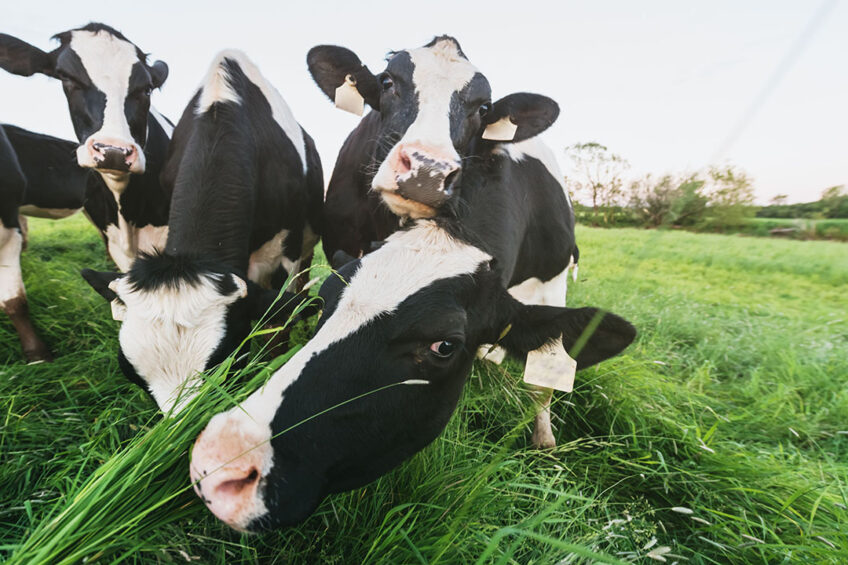Enhancing rumen health with water-soluble carbohydrates

Feedstuffs rich in water-soluble carbohydrates can support ruminal health, feed intake, and high milk production depending on the source, inclusion level, and the formulation of the entire diet.
Forages rich in water-soluble carbohydrates are an essential source of energy for dairy cattle during early lactation and they provide structural fibre to promote chewing and rumen buffering. In intensive dairy production systems, dairy cow rations comprise up to 300g of starch per kg dry matter, provided by maize silage, grains, and starch-rich by-products in the form of concentrate mixture to increase energy intake, production outcome, and feed conversion efficiency. However, excessive inclusion of concentrates lowers the total content of physical effective neutral detergent fibre for rumination and increases the incidence and severity of the subacute ruminal acidosis. Subacute ruminal acidosis enhances the risks for other metabolic disorders and raises serious animal welfare and ethical issues regarding dairy production. On the other hand, an increasing share of water-soluble carbohydrates in ruminant diets as an energy source improves the net food production index, supports high milk yields, increases cow performance and rumen health, and affects the sustainability of milk production.
Classification of plant carbohydrates
Plant carbohydrates are divided to cell wall and cell content carbohydrates. Cell wall carbohydrates include pectic substances, hemicellulose, and cellulose and cell content carbohydrates comprise of mono-, di-, and oligosaccharides, fructans and starch. Among the plant carbohydrates mono-, di-, and oligosaccharides, and fructans are considered as water-soluble carbohydrates.
Effects of water-soluble carbohydrates on ruminal pH
The fermentation rate of water-soluble carbohydrates by rumen microbiota depends on the type of carbohydrates, the cell wall integrity, and the degree of polymerisation. Mono- and disaccharides are quickly released from the plant cell or the feed matrix, captured by rumen microbiota and serve as energy sources. In some cases, mono- and disaccharides convert into microbial glycogen, and move to the small intestine to decrease ruminal acid load. However, excessive saccharides ferment to lactate and short-chain fatty acids and cause acute rumen acidosis or subacute ruminal acidosis. Restricted feeding with sucrose-rich diet in combination with starchy grains increase the risk of ruminal acidosis and systemic inflammation response. Oligosaccharides and fructans are less rapidly fermented into more acetate and butyrate and little to no lactate in the rumen; therefore, feeding forage rich in water-soluble carbohydrate shows only a moderate to low risk of subacute ruminal acidosis. Feeding starch-rich diets is accompanied with reduced bacterial diversity and species richness but feeding ryegrass hay rich in water-soluble carbohydrate supports fructanolytic bacteria such as Pseudobutyrivibrio ruminis which ferments carbohydrates into formate and butyrate.
Effects of water-soluble carbohydrates on feed intake and production
Feeding disaccharides such as sucrose, lactose, molasses, whey, or commercial liquid supplement based on molasses to dairy cows in early lactation phase increases dry matter intake, milk yield, and milk protein yield but reduces feed conversion efficiency. Feeding forage rich in water-soluble carbohydrates is sufficient for lactating cows producing 25 to 30 kg milk per day, but if the production level is above 30 kg milk per day, then an additional energy-rich concentrate is needed to meet the energy requirements.
Sustainable dairy cow feed source
Intensive dairy production systems need higher milk yields to stay economically competitive. Increasing the proportion of concentrate mixtures such as cereal grains provide the needed energy for higher milk yields, however, cereal grains are considered human-edible feed sources. On the other hand, forages from grasslands are completely human-inedible and therefore considered an important sustainable feed source for ruminants. In addition, increasing dietary water-soluble carbohydrates in the form of sucrose, lactose, molasses, whey, or commercial liquid supplement, improves the nitrogen use efficiency by dairy cattle and reduces nitrogen loss from the animal.
Concluding remarks
Proper feeding practices in intensive dairy production systems are critical to promote dairy cow health and welfare, and to alleviate negative environmental impacts. Feedstuffs rich in water-soluble carbohydrates, based on the source, inclusion level, and the formulation of the entire diet, can support ruminal health, feed intake, and high milk production. Although, further research is required to evaluate the variation in physiological needs for water-soluble carbohydrates in the early lactation diet, and to assess the potential of water-soluble carbohydrates other than from forages to increase the sustainability of dairy cow feeding.
The article was based on the article: Feeding hay rich in water‐soluble carbohydrates improves ruminal pH without affecting rumination and systemic health in early lactation dairy cows – by Fenja Klevenhusen, Maria‐Theresia Kleefisch and Qendrim Zebeli











